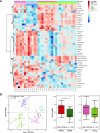APOE genotype influences the gut microbiome structure and function in humans and mice: relevance for Alzheimer's disease pathophysiology
- PMID: 30958695
- PMCID: PMC6593891
- DOI: 10.1096/fj.201900071R
APOE genotype influences the gut microbiome structure and function in humans and mice: relevance for Alzheimer's disease pathophysiology
Abstract
Apolipoprotein E (APOE) genotype is the strongest prevalent genetic risk factor for Alzheimer's disease (AD). Numerous studies have provided insights into the pathologic mechanisms. However, a comprehensive understanding of the impact of APOE genotype on microflora speciation and metabolism is completely lacking. In this study, we investigated the association between APOE genotype and the gut microbiome composition in human and APOE-targeted replacement (TR) transgenic mice. Fecal microbiota amplicon sequencing from matched individuals with different APOE genotypes revealed no significant differences in overall microbiota diversity in group-aggregated human APOE genotypes. However, several bacterial taxa showed significantly different relative abundance between APOE genotypes. Notably, we detected an association of Prevotellaceae and Ruminococcaceae and several butyrate-producing genera abundances with APOE genotypes. These findings were confirmed by comparing the gut microbiota of APOE-TR mice. Furthermore, metabolomic analysis of murine fecal water detected significant differences in microbe-associated amino acids and short-chain fatty acids between APOE genotypes. Together, these findings indicate that APOE genotype is associated with specific gut microbiome profiles in both humans and APOE-TR mice. This suggests that the gut microbiome is worth further investigation as a potential target to mitigate the deleterious impact of the APOE4 allele on cognitive decline and the prevention of AD.-Tran, T. T. T., Corsini, S., Kellingray, L., Hegarty, C., Le Gall, G., Narbad, A., Müller, M., Tejera, N., O'Toole, P. W., Minihane, A.-M., Vauzour, D. APOE genotype influences the gut microbiome structure and function in humans and mice: relevance for Alzheimer's disease pathophysiology.
Keywords: SCFAs; apolipoprotein E; butyrate; gut microbiota; metabolomics.
Conflict of interest statement
The authors thank the study participants for contributing samples and time to the studies used to generate the data. The authors also acknowledge the many CANN and COB trial colleagues who facilitated this study. This project was supported, in part by a Biotechnology and Biological Sciences Research Council (BBSRC) grant to the laboratory of A.-M.M. and D.V. (BB/M004449/1). Work in P.W.O.’s laboratory was supported, in part, by a Grant from the Science Foundation Ireland (APC/SFI/12/RC/2273) in the form of the Alimentary Pharmabiotic Centre (APC) Microbiome Ireland, the Food Institutional Research Measure (FIRM) Program, and the Immunomet Project of the Government of Ireland’s Department of Agriculture, Food, and the Marine. A.-M.M. and D.V. share senior authorship. The datasets used and/or analyzed during the current study are available at the NCBI Sequence Read Archive (SRA), under BioProject PRJNA533610. The authors declare no conflicts of interest.
Figures



References
-
- Tremlett H., Bauer K. C., Appel-Cresswell S., Finlay B. B., Waubant E. (2017) The gut microbiome in human neurological disease: a review. Ann. Neurol. 81, 369–382 - PubMed
-
- Minter M. R., Zhang C., Leone V., Ringus D. L., Zhang X., Oyler-Castrillo P., Musch M. W., Liao F., Ward J. F., Holtzman D. M., Chang E. B., Tanzi R. E., Sisodia S. S. (2016) Antibiotic-induced perturbations in gut microbial diversity influences neuro-inflammation and amyloidosis in a murine model of Alzheimer’s disease. Sci. Rep. 6, 30028 - PMC - PubMed
-
- Spor A., Koren O., Ley R. (2011) Unravelling the effects of the environment and host genotype on the gut microbiome. Nat. Rev. Microbiol. 9, 279–290 - PubMed
-
- Turpin W., Espin-Garcia O., Xu W., Silverberg M. S., Kevans D., Smith M. I., Guttman D. S., Griffiths A., Panaccione R., Otley A., Xu L., Shestopaloff K., Moreno-Hagelsieb G., Paterson A. D., Croitoru K.; GEM Project Research Consortium (2016) Association of host genome with intestinal microbial composition in a large healthy cohort. Nat. Genet. 48, 1413–1417 - PubMed
Publication types
MeSH terms
Substances
Grants and funding
LinkOut - more resources
Full Text Sources
Medical
Molecular Biology Databases
Miscellaneous

